
Herring are forage fish, mostly belonging to the family of Clupeidae.

Copepods are a group of small crustaceans found in nearly every freshwater and saltwater habitat. Some species are planktonic, some are benthic, a number of species have parasitic phases, and some continental species may live in limnoterrestrial habitats and other wet terrestrial places, such as swamps, under leaf fall in wet forests, bogs, springs, ephemeral ponds, and puddles, damp moss, or water-filled recesses (phytotelmata) of plants such as bromeliads and pitcher plants. Many live underground in marine and freshwater caves, sinkholes, or stream beds. Copepods are sometimes used as biodiversity indicators.

Richard Bowdler Sharpe was an English zoologist and ornithologist who worked as curator of the bird collection at the British Museum of natural history. In the course of his career he published several monographs on bird groups and produced a multi-volume catalogue of the specimens in the collection of the museum. He described many new species of bird and also has had species named in his honour by other ornithologists including Sharpe's longclaw and Sharpe's starling.

Harpacticoida is an order of copepods, in the subphylum Crustacea. This order comprises 463 genera and about 3,000 species; its members are benthic copepods found throughout the world in the marine environment and in fresh water. A few of them are planktonic or live in association with other organisms. Harpacticoida represents the second-largest meiofaunal group in marine sediments, after nematodes. In Arctic and Antarctic seas, Harpacticoida are common inhabitants of sea ice. The name Harpacticoida comes from the Greek noun harpacticon and the suffix -oid and means reminiscent of a predator.
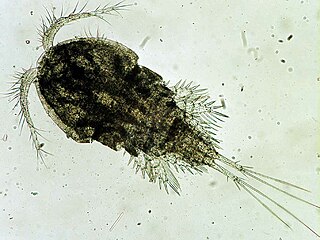
The Cyclopoida are an order of small crustaceans from the subclass Copepoda. Like many other copepods, members of Cyclopoida are small, planktonic animals living both in the sea and in freshwater habitats. They are capable of rapid movement. Their larval development is metamorphic, and the embryos are carried in paired or single sacs attached to first abdominal somite.
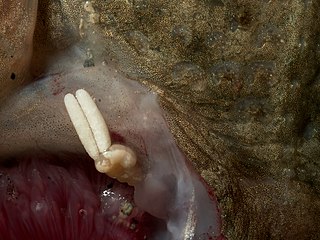
Chondracanthidae is a family of parasitic copepods, usually found infecting the branchial chamber of demersal fishes. It comprises the following genera:
Ventriculinidae is a family of cyclopoid copepods in the order Cyclopoida. There are at least two genera and three described species in Ventriculinidae.
Herpyllobiidae is a family of cyclopoid copepods in the order Cyclopoida. There are about 6 genera and more than 20 described species in Herpyllobiidae.
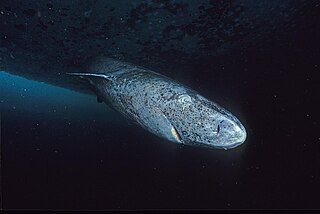
Ommatokoita is a monotypic genus of copepods, the sole species being Ommatokoita elongata. However, a specimen has been found on the skin of Etmopterus princeps assigned to the genus but not species.

Lernaeocera is a genus of marine copepods in the family Pennellidae, containing the following species:
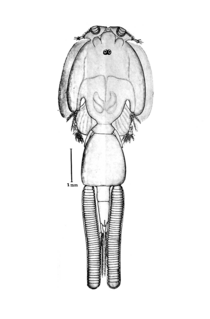
Caligus is a genus of sea lice in the family Caligidae. The species are parasites of marine fishes and could be vectors of viruses. As of 2017, the World Register of Marine Species includes the following species:

Lernaeopodidae is a family of parasitic copepods. The females are typically large and fleshy, and attach to the host permanently using a plug made of chitin called the bulla. The males cling on to the females using their antennae. They parasitize both marine and freshwater fish. Some lernaeopodids, including Clavella and Salmincola, can have negative impacts on fish in aquaculture.
Chondracanthus is a parasitic copepod genus in the family Chondracanthidae, containing the following species:

Lepeophtheirus is a genus of sea louse. The best-known species is L. salmonis, the salmon louse. Other species include L. pectoralis, which uses flatfish as its host, particularly the European flounder, and is also the type species of the genus Lepeophtheirus.
Mildred Stratton Wilson was an American zoologist, whose work on copepods was awarded a Guggenheim Fellowship in 1955.
Cardiodectes is a genus of copepods in the family Pennellidae. Species are parasites of fish.

Protosarcotretes is a genus of marine copepods in the family Pennellidae. Its type-species is Protosarcotretes nishikawai. This genus exhibits the most plesiomorphic states in the first to fourth legs of pennellids, and is differentiated from two closely related pennellid genera Sarcotretes and Lernaeenicus by the morphology of the oral appendages.
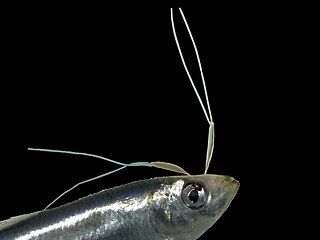
Lernaeenicus sprattae is a species of copepod in the family Pennellidae. It is a parasite of the European sprat and certain other fish and is sometimes known as the sprat eye-maggot.

Peniculus is a genus of marine copepods in the family Pennellidae. They occur worldwide and typically parasitize coastal or epipelagic fish, with the exception of Peniculus hokutoae that was found parasitizing a mesopelagic myctophid, Symbolophorus evermanni.













